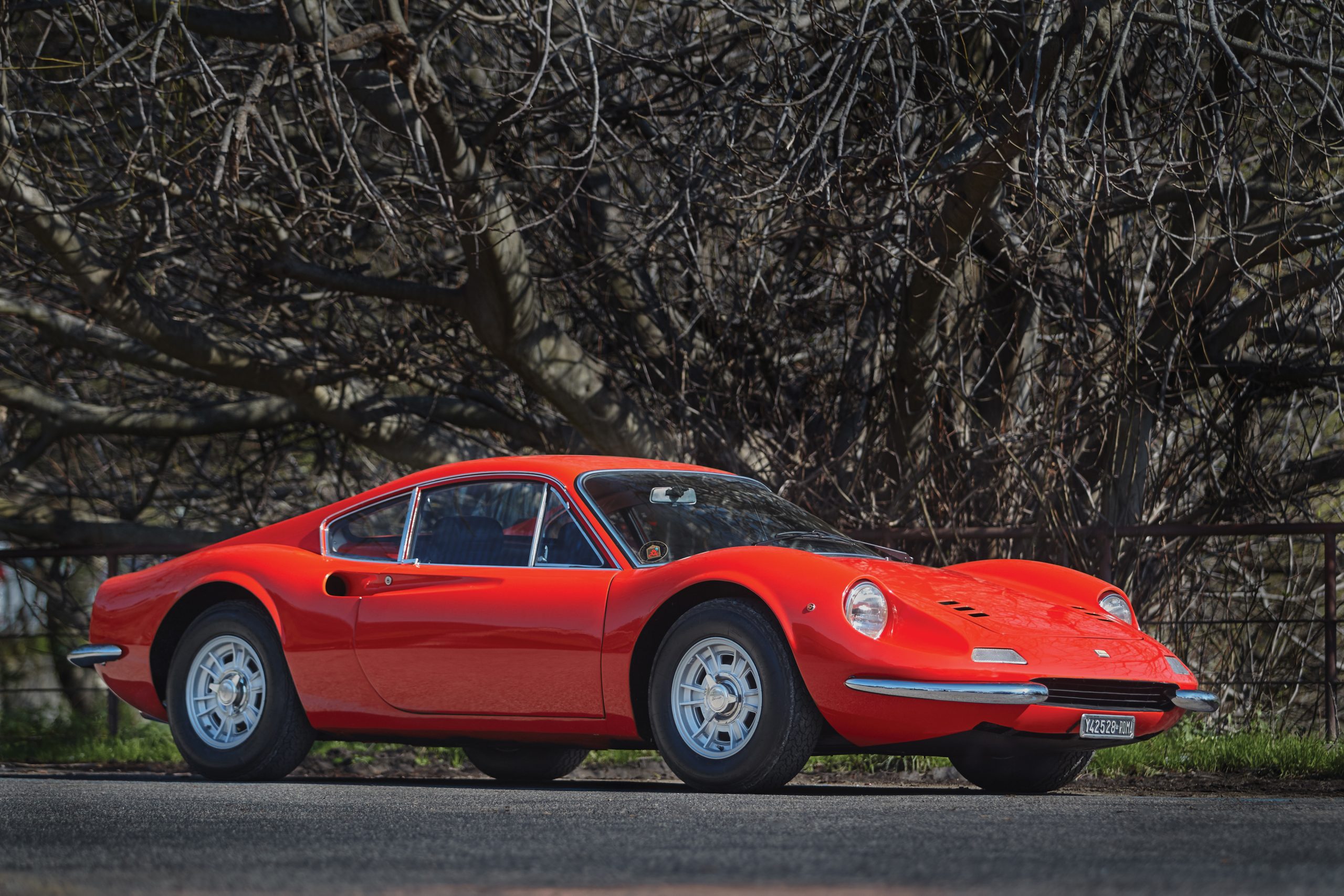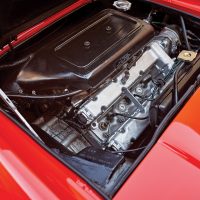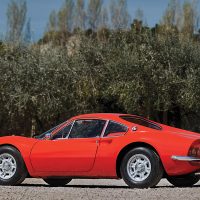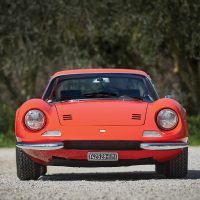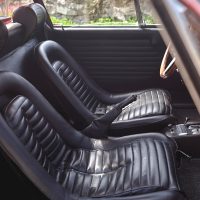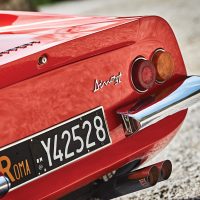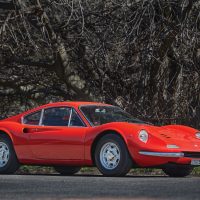SCM Analysis
Detailing
| Vehicle: | 1968 Ferrari 206 GT Dino |
| Years Produced: | 1967–68 |
| Number Produced: | 152 |
| Original List Price: | $13,000 |
| SCM Valuation: | Median price to date, $572,000; high sale, $803,000 |
| Distributor Caps: | $400 |
| Chassis Number Location: | Stamped on the driver’s side upper frame rail next to the engine |
| Engine Number Location: | Side of block before oil filter |
| Club Info: | Ferrari Club of America |
| Website: | http://www.FerrariClubofAmerica.org |
| Alternatives: | 1964 Alfa Romeo TZ-1, 1972–73 Porsche 911S, 1968 Mazda Cosmo Series I, 1968 Yenko Camaro |
| Investment Grade: | B |
This car, Lot 252, sold for $641,614, including buyer’s premium, at RM Sotheby’s Monaco Auction on May 14, 2016.
History lessons on the Dino 206 GT lean towards celebrating it as the first mid-engine production Ferrari.
The more important lesson is recognizing it as the first down-market Ferrari, opening the door for the incredible series of V8 Ferraris that followed.
Ferrari’s first attempt at a down-market car was in 1959. Ferrari put an 850-cc, 4-cylinder engine of their own design in a Fiat 1100 chassis with a unique Pininfarina-built 1100-style body. There was never an official project name, but the press called it the Ferrarina.
Enzo Ferrari drove it for a while as a personal car, but the project never advanced past the prototype stage.
The next attempt actually bore fruit.
Enter the ASA 1000 GT
A car nicknamed the Mille was shown at the 1961 Turin Salon. This time Ferrari stuck a 4-cylinder, 1-liter engine into a Fiat chassis. Race car wizard Giotto Bizzarrini designed the chassis. Gioacchino Colombo used his 12-cylinder Ferrari engine as inspiration when designing the new, 4-cylinder engine. Even the body had a celebrity association, as Giorgetto Giugiaro designed it during his tenure at Bertone.
A local industrialist bought the rights to produce the car from Ferrari. Marketed as the ASA 1000 GT, this baby Ferrari should have been a home run — but it wasn’t. A near $6,000 price tag and limited distribution doomed the model. About 120 cars were produced before the company was shuttered.
Italian scooter maker Innocenti was the next to take the plunge. For Innocenti, Ferrari powered a sporty coupe with a 1.8-liter V6. A proposed production of 2,000 Dino-powered cars was slated, but a weak scooter market killed the project almost before it began.
It turned out Fiat would be the first to produce a successful Ferrari-powered sports car. In an effort to homologate Ferrari’s Dino V6 engine for Formula II racing, Ferrari gave Fiat the contract to produce a run of the engine. Fiat, in turn, bought some of the engines and built a line of Fiat Dino coupes and spiders.
Finally a Ferrari — if not by name
Ferrari’s solo attempt began with the Dino 206 GT Speciale show car. Pininfarina built the car using a 206 S race car chassis. The engine used was a 4-cam Dino V6 derived from Ferrari’s Formula II race car. The 206’s engine was mounted midship, ahead of the rear axle. The body was an assembly of curved panels that loosely resembled Ferrari’s 365 P2 race car.
The Dino 206 GT Speciale was a hit on the show circuit, and soon other prototypes were making the rounds. Each progressive show car tamed the Dino 206 GT Special to the realities of production.
Bumpers were added, the roofline was raised, and the headlights were modified.
The Dino 206 Speciale show car turned into the Dino 206 GT production car. Ferrari designed and built the 206 GT chassis. The Pininfarina-designed aluminum 206 GT body was entrusted to Scaglietti for series production. Fiat built the 2-liter Dino V6 engine to a Ferrari Formula II-inspired design. The final assembly was done at Ferrari.
The first mid-engine Ferrari production car was ready for production, but it wasn’t going to be a Ferrari. Following the example of the V6-powered race cars that preceded it, the 206 GT was going to be branded a Dino — a first for a Ferrari production car.
The Dino’s price point was about half of a 12-cylinder Ferrari and it didn’t take a hard look to tell why. The use of the Fiat-built V6 was an obvious tell, and a look at the interior showed more evidence. The interior was trimmed in vinyl rather than leather.
There was no air conditioning, and the windows had cranks rather than electric motors. These omissions would be addressed as the model evolved — but at a cost that betrayed the original concept both in price and weight.
Introducing the Dino as a new brand confused the customers — and Ferrari’s marketing department. The car was designed by Ferrari, built by Ferrari, and marketed exclusively by Ferrari, so how could it not be a Ferrari? Ferrari had a duck that they couldn’t call a duck.
An original Dino brochure introduced the car as “almost a Ferrari.”
This was followed by a subsequent brochure which calls the car “proof of the constant development of the smaller Ferrari cars.” Any doubt the Dino was a Ferrari is dispelled by a look at the driver’s door jamb. The VIN plate clearly indicates the car as being produced by Ferrari.
Just a few daily drivers
206 GTs were sold to be used as everyday cars, and many were. They cost nearly as much as a 12-cylinder Ferrari to maintain, yet they were in the hands of people who often bought them on a budget. This recipe doesn’t bode well for finding good, low-mileage examples.
There were only 152 Dino 206 GTs built. Accidents, elements and deferred maintenance probably reduced that number by at least 30%. The romance of tracking down one of the rare and beautiful 206s has made them a darling of Ferrari collectors.
The combination of an aluminum body, aluminum engine and cool knockoff wheels creates a red mist that disguises the downsides of a serious lack of spare parts and engines prone to service issues.
RM Sotheby’s Dino 206 GT appears to be one of the few 206s to have been well kept and reasonably preserved. The $450,000 to $500,000 estimate was a rare case of an auction house undervaluing a car.
The bidding blew by the estimate to $641,614.
The money was a bit high — but not unprecedented. Good 206 GTs are as rare as unicorns. There are more buyers than cars, and even in a soft market they will sell well. The seller got the best of this deal, but the buyer didn’t get hurt. ♦
(Introductory description courtesy of RM Sotheby’s.)
